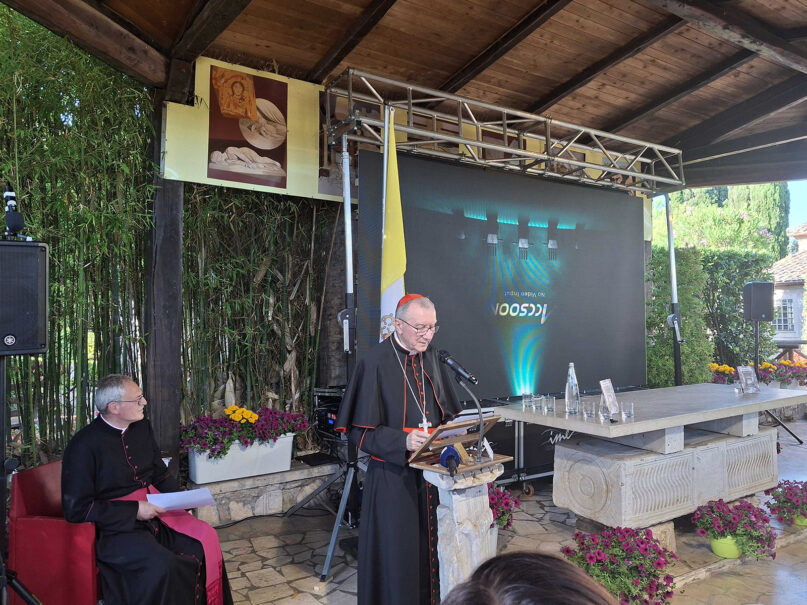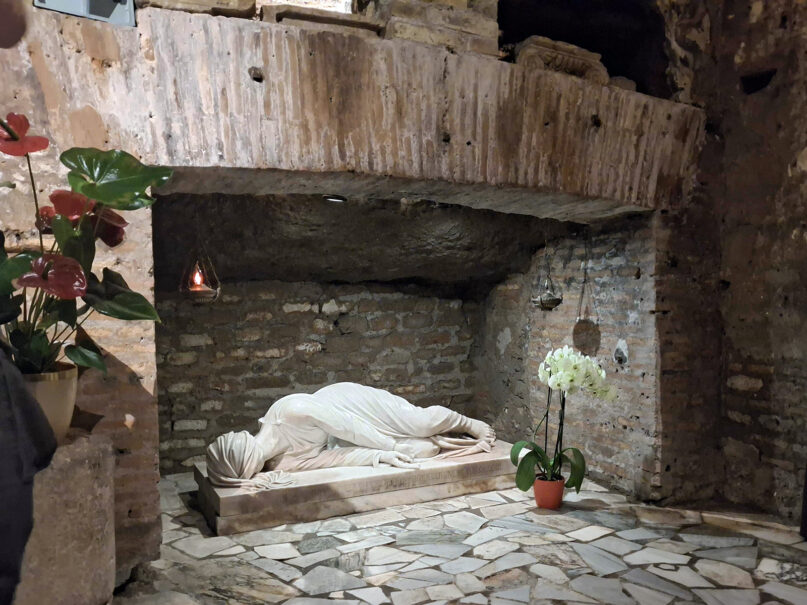VATICAN CITY (RNS) — Close to the start of the ancient Appian Way in Rome is the earliest known underground cemetery in the city, a network of catacombs containing remains of early Christian believers, popes and martyrs. On Wednesday (June 4), Vatican officials gathered with archaeologists and historians to celebrate the restoration of the tomb of St. Eusebius, a fourth-century pope who, after only four months as pontiff, was exiled to Sicily by Emperor Maxentius.
The tomb, in a complex known as the Catacombs of St. Callistus, has its own spacious room, a rare honor in the tight confines of most Roman catacombs. Adorned with marble and mosaics, its vault was painted with geographical shapes in red and blue. A hole in the high wall allowed natural light to enter the crypt. A large marble slab is inscribed with an epitaph for Eusebius, which recounts the goodness and mercy of the deceased pope.
As pope, Eusebius was in favor of forgiving the “lapsi” — those who recanted the Christian faith to avoid persecution or death, citing Christ’s call to forgive sinners if they repented. His opponent Heraclius made the case that they should not be allowed to rejoin the Christian community. When Heraclius was elected anti-pope by his faction, it led to upheaval in Rome, leading the emperor to cast the leaders out of the city.
The restoration team began its work in 2023 to repair the effects of time on the burial room. As they worked, they were able to reconstruct the traces of what it might have looked like in the past.
The tomb “brings us back to the roots of the Roman Church at a historical time that was particularly sensitive and difficult,” said Cardinal Pietro Parolin, the Vatican secretary of state, in his remarks at the event. “This most recent restoration reflects the desire to safeguard and promote the ancient memories of the witnesses to the faith.”

Cardinal Pietro Parolin speaks during an event at the Catacombs of St. Callistus, June 4, 2025, in Rome. (RNS photo/Claire Giangravé)
The restoration was carried out by the Pontifical Commission for Sacred Archaeology, established by Pope Pius IX in 1852 to protect the burial sites of the early Christian communities. The commission was the brainchild of the famed Roman archaeologist Giovanni Battista de Rossi, who was only 22 in 1844 when he stumbled onto the Catacombs of St. Callistus while walking with his brother on the Appian Way.
The catacombs contain one of the first papal burial sites, and altogether nine popes and eight other bishops are buried there. When Rossi discovered the room containing the tombs of the popes in 1854, he described it as the “little Vatican,” referring to where popes are usually buried today. (Pope Francis followed the example of other pontiffs who chose to be buried outside the Vatican.)

A replica of a statue of St. Cecilia is placed at her original burial site in the restored Catacombs of St. Callistus, June 4, 2025, in Rome. (RNS photo/Claire Giangravé)
St. Cecilia, the patron saint of music, was buried in the catacomb before her body was moved to a basilica built in her honor in 821 to protect her remains from being raided during the numerous invasions that threatened Rome. A replica of the statue of Cecilia by Stefano Maderno is currently placed on her original burial place.
Through the labyrinth of corridors of the catacombs lined with the tombs of believers and martyrs, symbols drawn from the Hebrew Bible and the New Testament illustrate Christian beliefs, especially the hope of the Resurrection. Graffiti left by the first pilgrims who visited the burial sites can still be found, along with the remains of the small oil lamps that they used to make their way in the dark underground space.
The restoration was possible thanks to the financing of the Patrum Lumen Sustine foundation, a Swiss and Italian organization that supports the preservation of the patrimony of Western culture, and the state of Azerbaijan, which has a partnership with the Vatican and the Italian state to preserve ancient Christian sites.
Catacombs of St. Callistus Photo Gallery
Since the 1930s, the Catacombs of St. Callistus has been run by the Salesians of Don Bosco, a religious order also known as the Society of St. Francis de Sales, who offer tours to visitors. The Salesians “are the servants who accompany droves of people every day,” said Cardinal Ángel Fernández Artime, former head of the Salesian order, speaking at the event. “Often those who enter as a tourists emerge as pilgrims, because the welcoming they find touches the heart of many.”
The restoration of the tomb coincides with the Jubilee Year, an anniversary celebration of the church that draws thousands of pilgrims to Rome and its holy sites to ask forgiveness for their sins. This year also marks the centenary of the decree that established the Pontifical Archaeological Commission.
Parolin praised the commission for offering the opportunity “of entering a dialogue with our ancestors in the faith, who through symbols, images and writings speak to us about hope. A strong hope that does not backpedal when faced with challenges and obstacles. A luminous faith that destroys the darkness of death to point to a path leading to the ultimate destination, to complete happiness, to peace in God and with God.”



